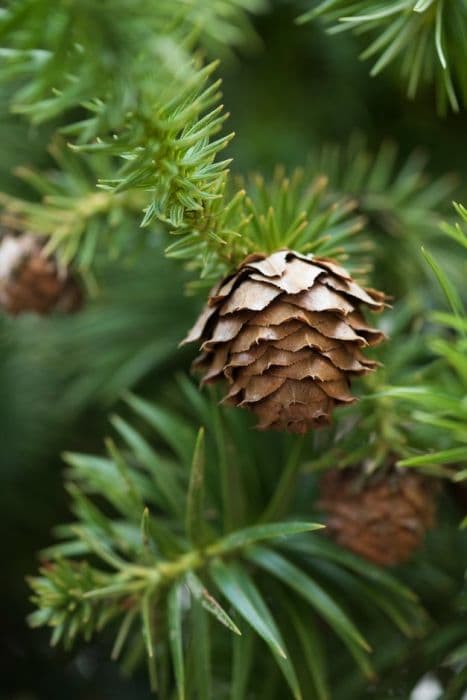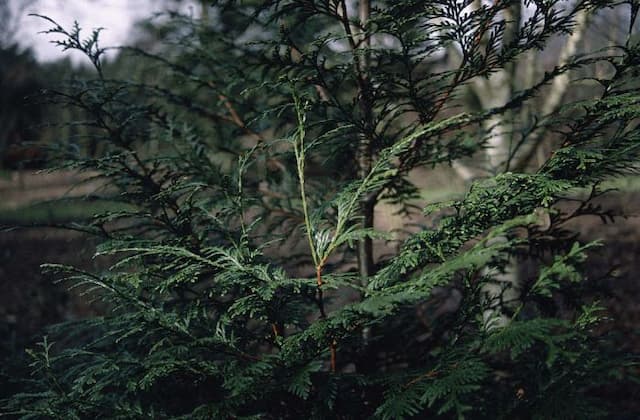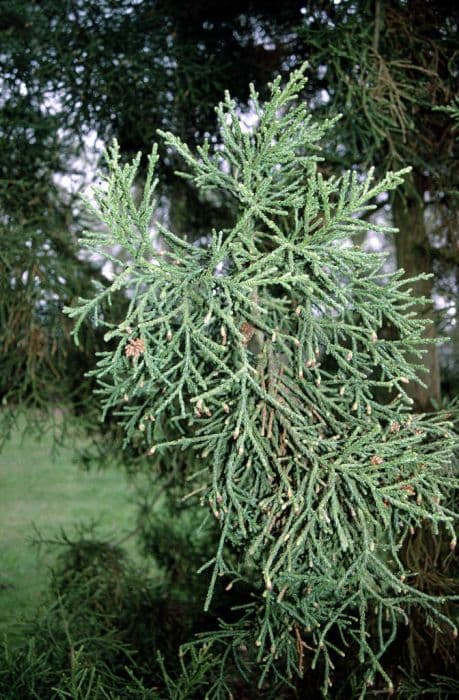Leyland Cypress × Cuprocyparis notabilis

ABOUT
× Cuprocyparis notabilis, more commonly known as Leyland Cypress, is a coniferous evergreen that is well known for its dense, compact foliage. Its leaves are scale-like, with a rich green color that adorns the flattened sprays of its branches. These leaves can sometimes present a slightly bluish or grayish green hue, depending on the variety and growing conditions. The overall shape of the Leyland Cypress is generally pyramidal to columnar, giving it a stately and formal appearance that is favored in many landscape designs. The bark of this plant is usually a reddish-brown color, which fissures with age and can add textural interest to the visual profile of the tree. It produces small, rounded cones, usually not longer than an inch, which are green when young and turn brown as they mature. The Leyland Cypress has a vigorous growth habit and displays a symmetrical, densely foliated form. It offers excellent coverage and is often used for privacy screens or windbreaks as a result. The appearance of the Leyland Cypress can vary based on pruning and maintenance practices, allowing for a range of uses in both residential and commercial landscaping. Its broad, sweeping branches create a soft yet full silhouette, with the year-round color making it a popular choice for those seeking an evergreen planting solution.
About this plant
 Names
NamesFamily
Cupressaceae
Synonyms
Notable Cypress, Hybrid Cypress
Common names
× Cuprocyparis notabilis.
 Toxicity
ToxicityTo humans
The × Cuprocyparis notabilis, commonly known as Leyland cypress, is not known to be toxic to humans. Therefore, ingesting parts of this plant typically does not result in poisoning or adverse health effects.
To pets
The Leyland cypress (× Cuprocyparis notabilis) is not considered toxic to pets either. It is generally regarded as safe, and there are no known toxic effects from pets ingesting parts of this plant. However, it's always prudent to prevent pets from eating plants as individual animals may have unique sensitivities or allergic reactions.
 Characteristics
CharacteristicsLife cycle
Perennials
Foliage type
Evergreen
Color of leaves
Green
Height
60 feet (18 meters
Spread
20 feet (6 meters
Plant type
Tree
Hardiness zones
7
Native area
Cultivar
Benefits
 General Benefits
General Benefits- Ornamental Value: × Cuprocyparis notabilis, also known as Leyland Cypress, has a fast-growing, conical shape that makes it popular in landscaping and garden design.
- Noise Reduction: Its dense foliage can act as a sound barrier, reducing noise pollution when used as a hedging plant.
- Windbreak: Leyland Cypress is often planted in rows to serve as a shelterbelt or windbreak, protecting more sensitive plants and reducing wind speed on properties.
- Privacy Screen: Due to its height and dense growth, it provides an effective visual screen, offering privacy for homes and gardens.
- Erosion Control: The root system of Leyland Cypress helps stabilize the soil, which can prevent erosion on slopes and in areas prone to soil degradation.
- Wildlife Habitat: The tree can provide shelter and nesting sites for birds and other wildlife.
- Seasonal Interest: Although it is an evergreen, Leyland Cypress can change colour slightly with the seasons, adding variety to the landscape throughout the year.
 Medical Properties
Medical PropertiesThis plant is not used for medical purposes.
 Air-purifying Qualities
Air-purifying QualitiesThis plant is not specifically known for air purifying qualities.
 Other Uses
Other Uses- x Cuprocyparis notabilis, also known as the Leyland cypress, can be used as a windbreak or privacy screen due to its dense growth habit.
- The wood from the Leyland cypress is sometimes used in woodworking projects, particularly those requiring softwood, such as lightweight furniture or plywood.
- Leyland cypress can be shaped into topiary, offering an artistic element to gardens and landscapes with their ability to be trimmed into various formal shapes.
- The tree is used in the Christmas tree industry because of its symmetrical shape and evergreen foliage, providing a festive option for the holiday season.
- The Leyland cypress serves as a noise barrier, with its dense foliage helping to reduce sound from traffic or industrial sources when planted in rows.
- In horticulture, the Leyland cypress is used as rootstock for grafting other conifer species, helping to propagate cultivars that might otherwise be difficult to grow.
- This tree is incorporated into wildlife gardens to provide habitat and nesting sites for birds, as its dense branches offer shelter and protection.
- The Leyland cypress can be used as a backdrop for garden beds, where its evergreen presence can highlight the colors and textures of flowering plants in front of it.
- Some craftsmen use the aromatic wood shavings and sawdust of the Leyland cypress in potpourri mixes or as natural insect repellents.
- The Leyland cypress's quick growth rate makes it a candidate for biomass production, contributing to renewable energy efforts through the generation of biofuel.
Interesting Facts
 Feng Shui
Feng ShuiThe plant Leyland Cypress is not used in Feng Shui practice.
 Zodiac Sign Compitability
Zodiac Sign CompitabilityThe plant Leyland Cypress is not used in astrology practice.
 Plant Symbolism
Plant Symbolism- Longevity: As a cypress variety, × Cuprocyparis notabilis, commonly known as Leyland Cypress, often symbolizes long life due to its potential to live for several decades and its evergreen nature. This represents enduring existence through the seasons.
- Strength: The Leyland Cypress is known for its robust and fast-growing characteristics, making it a symbol of strength and resilience in the face of environmental challenges.
- Privacy: Due to its dense foliage and common use as a privacy hedge, the Leyland Cypress can symbolize the desire for seclusion or sanctuary from the outside world.
- Eternal Peace: Cypress trees are traditionally associated with cemeteries and the afterlife; therefore, the Leyland Cypress can represent eternal peace and the enduring nature of the soul.
 Water
WaterThe Leyland Cypress, which is the most common common name for × Cuprocyparis notabilis, requires consistent moisture but doesn’t do well with overwatering. Ensure the soil is well-draining and water the plant deeply when the top few inches of soil feel dry to the touch, which usually amounts to once a week during hot dry weather. In cooler temperatures or when rainfall is abundant, watering frequency can be reduced. Provide about 1 to 2 gallons per watering for young trees, increasing the amount as the tree matures and depending on the size and environmental conditions.
 Light
LightThe Leyland Cypress thrives in full sunlight, which means it should receive at least 6 hours of direct sun per day. It's best to place the plant in an open area where it is not overshadowed by taller structures or trees. This sun-loving conifer will perform well and grow dense foliage when situated in a spot that meets its light exposure needs.
 Temperature
TemperatureLeyland Cypress is hardy and can tolerate a temperature range from down to about 0°F to up above 100°F, but it thrives best in temperatures between 50°F and 80°F. Sudden drops below freezing can be harmful especially to young plants, so providing some wind protection can help in managing temperature stress.
 Pruning
PruningPrune Leyland Cypress for shape and size management in late winter or early spring before new growth starts. Pruning may also be necessary to remove dead or damaged branches which can be done at any time of year. Annual pruning helps maintain the desired height and density of the hedge or tree, improving air circulation and enhancing the plant's overall health.
 Cleaning
CleaningAs needed
 Soil
SoilLeyland Cypress thrives in well-draining soil with a pH between 5.5 and 7.0. The best soil mix for this tree is a blend of loam, peat, and sand to ensure proper drainage and aeration. Slight acidity to neutral pH is ideal for nutrient absorption.
 Repotting
RepottingLeyland Cypress trees, being large and potentially fast-growing, do not typically require frequent repotting. They are usually planted directly in the ground. However, if grown in containers, repotting every 2-3 years or when rootbound is recommended to ensure sufficient space for root growth.
 Humidity & Misting
Humidity & MistingLeyland Cypress prefers moderate humidity but is adaptable to various conditions. It can tolerate some dryness but benefits from a climate with regular humidity levels, avoiding excessively arid or overly moist environments.
 Suitable locations
Suitable locationsIndoor
Grow Leyland Cypress indoor near a sunny window with good air flow.
Outdoor
Plant Leyland Cypress in sunny spot, protect from strong winds.
Hardiness zone
6-10 USDA
 Life cycle
Life cycle× Cuprocyparis notabilis, commonly known as Leyland Cypress, begins its life with the germination of a hybrid seed, which requires a warm, moist environment to sprout. The seedling then develops into a juvenile plant featuring a single leader and horizontal branching, characteristic of its coniferous nature. As the Leyland Cypress matures, it undergoes a period of rapid vertical growth, often gaining several feet per year, and its evergreen foliage becomes dense, creating a conical or columnar shape. Once the tree reaches reproductive maturity, it produces small, round cones that contain the seeds for the next generation, although reproducing true to type might be limited due to its hybrid nature. The Leyland Cypress, being a long-lived tree, can remain in its mature stage for several decades, providing screening and ornamental value. Eventually, the tree enters a senescence phase, where growth slows and it becomes more susceptible to diseases and environmental stresses, leading ultimately to its decline and death.
 Propogation
PropogationPropogation time
Spring-Early Summer
The Leyland cypress, scientifically known as × Cuprocyparis leylandii, is most commonly propagated by cuttings. This method is popular due to its simplicity and high success rate. To propagate the Leyland cypress by cuttings, take a 4 to 6 inch (approximately 10 to 15 centimeters) cutting from the current year's growth during the late fall or early winter when the tree is dormant. Ensure the cutting includes at least one set of leaves or nodes. Dip the cut end in rooting hormone to encourage root development and plant it in a well-draining soil mix. Keep the soil consistently moist and provide indirect light until the cutting has rooted, which can take a few weeks to a few months. Once rooted, the new Leyland cypress can be transplanted to a more permanent location in the garden.









